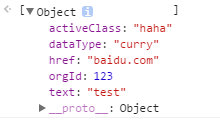DIV+CSS佈局教程網 >> 網頁腳本 >> JavaScript入門知識 >> 關於JavaScript >> 關於JSON.parse(),JSON.stringify(),jQuery.parseJSON()的用法
關於JSON.parse(),JSON.stringify(),jQuery.parseJSON()的用法
編輯:關於JavaScript
1. JSON.parse(jsonString): 在一個字符串中解析出JSON對象
var str = '[{"href":"baidu.com","text":"test","orgId":123,"dataType":"curry","activeClass":"haha"}]';
JSON.parse(str);
結果:

2. JSON.stringify(obj) : 將一個JSON對象轉換成字符串
var obj = [{"href":"baidu.com","text":"test","orgId":123,"dataType":"curry","activeClass":"haha"}];
JSON.stringify(obj);
結果:
"[{"href":"baidu.com","text":"test","orgId":123,"dataType":"curry","activeClass":"haha"}]"
3. jQuery.parseJSON(jsonString) : 將格式完好的JSON字符串轉為與之對應的JavaScript對象
var str = '[{"href":"baidu.com","text":"test","orgId":123,"dataType":"curry","activeClass":"haha"}]';
jQuery.parseJSON(str);
結果:

4.JSON.parse()和jQuery.parseJSON()的區別:
有的浏覽器不支持JSON.parse()方法,使用jQuery.parseJSON()方法時,在浏覽器支持時會返回執行JSON.parse()方法的結果,否則會返回類似執行eval()方法的結果,以上結論參考jquery 1.9.1 得出:
parseJSON: function( data ) {
// Attempt to parse using the native JSON parser first
if ( window.JSON && window.JSON.parse ) {
return window.JSON.parse( data );
}
if ( data === null ) {
return data;
}
if ( typeof data === "string" ) {
// Make sure leading/trailing whitespace is removed (IE can't handle it)
data = jQuery.trim( data );
if ( data ) {
// Make sure the incoming data is actual JSON
// Logic borrowed from http://json.org/json2.js
if ( rvalidchars.test( data.replace( rvalidescape, "@" )
.replace( rvalidtokens, "]" )
.replace( rvalidbraces, "")) ) {
return ( new Function( "return " + data ) )();
}
}
}
jQuery.error( "Invalid JSON: " + data );
},
以上這篇關於JSON.parse(),JSON.stringify(),jQuery.parseJSON()的用法就是小編分享給大家的全部內容了,希望能給大家一個參考,也希望大家多多支持。
小編推薦
熱門推薦